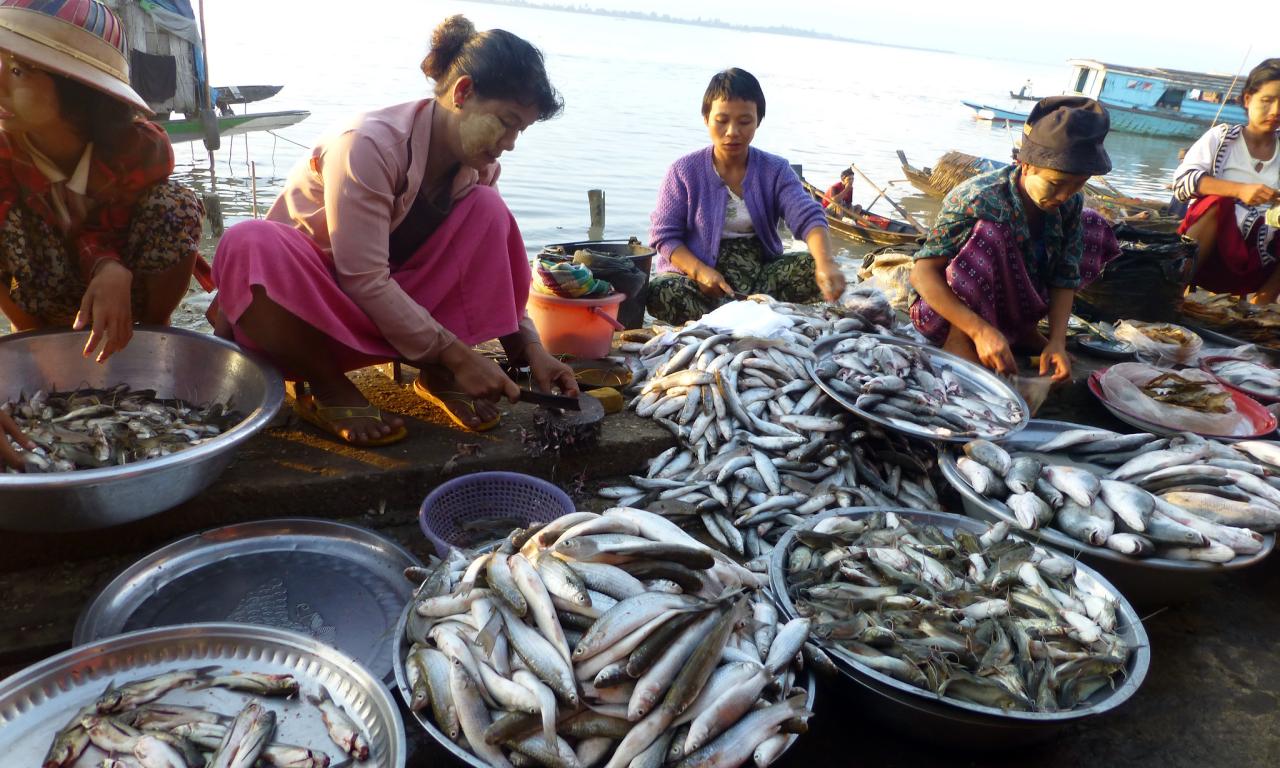
Small scale fisheries feed millions power local economies and protect marine ecosystems yet their true value has long been ignored. New research published in Nature is changing that. In this interview Dr. David Mills, a project principal investigator, co-author in the research and WorldFish Principal Scientist explains what the findings mean for policy, nutrition, and the future of global fisheries management
How did this paper come to be?
David Mills: The Illuminating the Multidimensional Contributions of Small-Scale Fisheries paper is the outcome of an extensive project based on the larger Illuminating Hidden Harvests report. That report spans 330 pages and includes contributions from over 800 people across five years. It’s a massive effort, comprising 56 country case studies aimed at synthesizing new information about small-scale fisheries worldwide. The main objective is to shine a spotlight on the diverse contributions of small-scale fisheries to sustainable development.
Often, we think of fisheries solely in terms of fish landings or economic value. But there is so much more to small-scale fisheries than just those figures. They support livelihoods, enhance environmental sustainability, provide critical nutrition, and include significant gender dimensions, especially with women’s roles. These contributions are rarely considered in conventional assessments of small-scale fisheries. This report brings all this information together to demonstrate the multidimensional importance of small-scale fisheries to sustainable development.
The study itself is the second in a series that I had the opportunity to help conceptualize back in 2007. At that time, a group from FAO, the World Bank, and I designed what was then called the "Big Numbers Project." That initiative evolved into the Hidden Harvests report, which the World Bank produced in 2012. Since then, the concept has garnered even more attention, culminating in this larger and more comprehensive iteration. This paper synthesizes five critical dimensions into a unified piece that urges people to consider the broad and multidimensional contributions of small-scale fisheries.
Why does it matter that we look at these broader contributions?
David Mills: Understanding these multidimensional contributions is essential because it directly informs how we manage small-scale fisheries. When fisheries are viewed narrowly—for example, just in terms of their economic value or their yield—the resulting management strategies often fail to account for their broader societal and environmental significance.
For instance, if you manage small-scale fisheries purely for economic returns, you might miss out on optimizing other critical benefits, such as livelihoods, nutrition, and community well-being. Effective fisheries management requires a more holistic approach, one that ensures the benefits of small-scale fisheries are equitably distributed and sustainable over the long term. By considering all these dimensions—economic, nutritional, social, and environmental—we can create policies and management strategies that truly work for the people who depend on these resources the most.

What’s new in this publication?
David Mills: What’s new in this study is its ability to bring together multidisciplinary and cross-sectoral data into a single comprehensive analysis. The team worked with over 800 contributors to gather data that had often been siloed—for example, economic surveys, nutrition studies, and fisheries data that had never been linked before. By integrating these diverse datasets, we created a resource that reveals the full spectrum of benefits provided by small-scale fisheries.
This effort also led to the development of new methodologies, training materials, and collaborations with countries to improve how small-scale fisheries are accounted for in national statistics and management systems. These innovations are critical for reshaping how small-scale fisheries are valued and managed on a global scale.
What’s next for this work?
David Mills: The project’s impact goes far beyond the report and the databases. Moving forward, the focus is on embedding the methodologies and insights from this study into national systems. Organizations like FAO, Duke University, WorldFish, and others are working directly with national fisheries systems to help them understand and apply these methods in their own contexts.
For example, we’re collaborating with governments to integrate this data into policy discussions, raising the profile of small-scale fisheries in national and international forums. This approach helps ensure that small-scale fisheries aren’t seen solely as economic activities but as vital contributors to livelihoods, nutrition, and community resilience.
Would you say this serves as a tool for fishers to advocate for themselves?
David Mills: Advocacy is an interesting term because it has a unique relationship with science. While this study provides valuable data that small-scale fisheries organizations can use to advocate for their needs, it’s also about improving fisheries management and governance.
We’ve worked closely with fishers, government agencies, and other stakeholders to understand their priorities. This means the tools and insights developed from the project can serve different purposes for different groups. For fishers, it might be about gaining agency and governance rights over their resources. For governments, it’s about improving management systems and recognizing the full value of small-scale fisheries.
What do you personally hope happens with this work?
David Mills: I’d love to see this work applied directly to improve fisheries management systems and policies. For example, in Timor-Leste, where I work extensively, WorldFish is building systems that incorporate cultural and economic dimensions to better understand small-scale fisheries. This helps ensure that fisheries management not only supports yield and economic value but also addresses the nutritional and social needs of communities. FAO and Duke University are also now working with governments in a number of African and central American countries to incorporate some of these methods and approaches.
Globally, I hope this study continues to promote the idea of putting fishers at the centre of fisheries management processes. By doing so, we can create systems that work for both the environment and the people who depend on it, ensuring that small-scale fisheries can thrive for generations to come.
What big numbers from the report that really stood out to you?
David Mills: One of the most striking findings is the sheer scale of small-scale fisheries. They account for 40% of the global fisheries catch—about 40 million tons annually—and employ 60 million people directly, with another 52 million fishing for subsistence. When you factor in the people relying on these fishers, that’s 492 million people globally—about 1 in 12 of the world’s population.
From a nutritional perspective, small-scale fisheries could meet half the daily omega-3 fatty acid needs for nearly a billion women worldwide. These numbers highlight the critical role small-scale fisheries play in global food security and nutrition.
The publication of Illuminating the Multidimensional Contributions of Small-Scale Fisheries in Nature highlights a profound shift in understanding small-scale fisheries. These fisheries are not just about economics or environmental impact, they underpin the health, resilience, and livelihoods of hundreds of millions of people worldwide. This research sets a foundation for more equitable policies and sustainable practices, ensuring small-scale fisheries continue to play their crucial role in global food systems and sustainable development.
